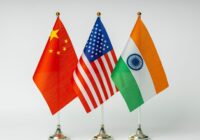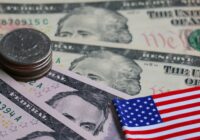The immense success of Robin DiAngelo’s book, “White Fragility,” reveals a secret that American publishers have been waiting for decades to unearth. Book titles are important. Publishers spend time searching for the title that will turn a promising book into the next explosive No. 1 bestseller. It turns out to be a lot simpler than some imagined. The secret — revealed for the first time here on Fair Observer — is to include the word for a color in the title. Though of a totally different genre, “White Fragility” is the worthy successor of “Fifty Shades of Grey,” a book that sold over 100 million copies.
This exclusive Daily Devil’s Dictionary theory about the crucial importance of a reference to color in the title of a bestseller, as expressed in the paragraph above, deserves at least as much consideration as Dr. DiAngelo’s theory about the viral component of racism she calls “white fragility.” Both are built on a reductionist principle that takes a superficial similarity as the incontrovertible proof of a simplistic, all-encompassing thesis.
The Sadly Illusory Spontaneity of the Super-Rich
DiAngelo, an American academic, is of course right to signal that racism in the US is a systemic problem whose roots sink deep within the American psyche. But her thesis that has seduced so many in the media not only reduces complex social issues to a single mental state but, more worryingly, expresses a fatalism leading to the conclusion that there’s not much we can do about it. Matt Taibbi, an author and journalist, calls DiAngelo’s book a “guide to egghead racism” that “reduces everything, even the smallest and most innocent human interactions, to racial power contests.”
Here is today’s 3D definition:
Fragility:
Psychological confusion that undermines one’s identity. The principal psychological characteristic of writers with theories about race that have no scientific validity but are capable of seducing a public in need of the comforting idea that their own disarray is due to the naturally confused state of human understanding among members of a dominant culture.
Contextual Note
The words frailty and fragility in English both derive from the Latin word fragilitatem. Why they have both survived in English is something of a puzzle. Does the language need two distinct but similar words to express what some dictionaries define as “moral weakness”? Fragility calls to mind the packaging of delicate objects that risk breaking during transport, whereas frailty seems closer to the idea of not being sure of oneself or consistent with one’s principles. DiAngelo has implicitly created the image of white people as being in danger of breaking, like a porcelain dish or a clay statue whose packaging will carry a sticker with the word “fragile” printed in red.
The New Yorker, in its favorable review of the book summing up DiAngelo’s thesis, asserts that “the racial beliefs and responses that feel authentic or well-intentioned have likely been programmed by white supremacy, to perpetuate white supremacy.” Stated in this way, there’s no point in fighting it. It’s in the program, like the Y2K bug. White supremacy has already won the war. The only thing left to do — and Americans always want to know what they are supposed to do — is to meditate on DiAngelo’s wisdom or hire a new coder and write a new program.
For someone who is paid to train people in multicultural awareness, DiAngelo appears to be unfamiliar with the work of great thinkers in the field of intercultural communication, at least since anthropologist Edward T. Hall’s seminal 1959 book, “The Silent Language.” Culture is complex, consisting of shared systems of perception and communication while constructing assumptions about how the world functions. The coexistence of cultures is always problematic. Race is merely a component of culture. Because it is a visible sign of difference, it carries a special impact. DiAngelo seems to believe that race fatally defines both culture and identity. In her reading, whites are one way, blacks are another. That’s it. Learn to live with it.
For all her research into interracial relations, DiAngelo seems interested in neither the systemic nature of culture nor the specific historical reality that spawned contemporary forms of racism. She complains, for example, that American individualism is designed to further white fragility, whereas it exists at the core of US culture as a factor to support an economic system that imposes competition as a way of life. Such a system finds racist principles to be useful (i.e., profitable) in diminishing the power of expression of a multiracial working class. It isn’t primarily about the psychology of whites, their view of blacks and their anguished sense of their own identity. It’s about economic interests and the structuring of a class system for the benefit of the oligarchs who are in control.
Historical Note
White economic exploitation of other races truly began five centuries ago when Europeans discovered that the darker populations of the world lived in regions where there were valuable resources insufficiently exploited by the locals. White adventurers understood that there was profit in the air if only one had the courage to impose one’s ideas and follow one’s instincts, knowing they could count on the support of their governments. Racism has always depended on the perception of economic interest. In a curious twist, Robin DiAngelo doesn’t seem aware of the history because she herself is a victim of the culture of individualism she criticizes. For her, the problems are in each white person’s heads, not in their society’s history.
Matt Taibbi reminds us that “DiAngelo isn’t the first person to make a buck pushing tricked-up pseudo-intellectual horseshit as corporate wisdom.” In her original 2011 paper, “White Fragility,” DiAngelo reveals what her thesis is really about: her own competitive place in the culture. Here is how she frames it: “White people often believe that multicultural / anti-racist education is only necessary for those who interact with ‘minorities’ or in ‘diverse’ environments. However, the dynamics discussed here suggest that it is critical that all white people build the stamina to sustain conscious and explicit engagement with race.”
In other words: Buy my consulting services. Her initial essay was a sales pitch with the specific aim of increasing the size of the market segment requiring her services as a consultant and trainer. In an article on Medium, Anne Baily brutally sums it up in these terms: “DiAngelo teaches that you must work toward being antiracist. For a small fee of $10,000, Robin DiAngelo can help you atone for your evils at one of her seminars.” Competition is the root of all evil, and especially the evil of racism.
Although DiAngelo cites Frantz Fanon in her bibliography, there is little evidence that she has attempted to understand how Fanon’s thinking evolved from “Black Skin, White Masks” in 1952 — where he did affirm a kind of fatality similar to DiAngelo’s contention that black and white identities are separate and opposed — to “The Wretched of the Earth” in 1961, which found him insisting on a revolutionary struggle to create a “new man.”
Throughout his work, the francophone black man, who moved from Martinique to Algeria in 1953 and eventually accompanied that nation’s epic anti-colonial revolution, reflected on the complex history of European colonialism. Fanon showed only minimal interest in the specific case of the United States, a nation that has always sought to sever its relationship with history after symbolically breaking free from Europe in 1776. Fanon understood that black and white relations take their meaning within the broader context of colonialism, which is economic and cultural before it is racial.
What would Fanon have thought of the idea of white fragility? Probably not much. At least he might approve DiAngelo’s perception of racism as a problem. But does it really matter whether white Americans are plagued by an awareness of their own fragility? On the contrary, white anguish can be seen as a trivial problem at what may be a pivotal moment in history as today’s protesters of all races appear to have sensed the possible emergence of Fanon’s “new man.”
*[In the age of Oscar Wilde and Mark Twain, another American wit, the journalist Ambrose Bierce, produced a series of satirical definitions of commonly used terms, throwing light on their hidden meanings in real discourse. Bierce eventually collected and published them as a book, The Devil’s Dictionary, in 1911. We have shamelessly appropriated his title in the interest of continuing his wholesome pedagogical effort to enlighten generations of readers of the news. Click here to read more of The Daily Devil’s Dictionary on Fair Observer.]
The views expressed in this article are the author’s own and do not necessarily reflect Fair Observer’s editorial policy.
Support Fair Observer
We rely on your support for our independence, diversity and quality.
For more than 10 years, Fair Observer has been free, fair and independent. No billionaire owns us, no advertisers control us. We are a reader-supported nonprofit. Unlike many other publications, we keep our content free for readers regardless of where they live or whether they can afford to pay. We have no paywalls and no ads.
In the post-truth era of fake news, echo chambers and filter bubbles, we publish a plurality of perspectives from around the world. Anyone can publish with us, but everyone goes through a rigorous editorial process. So, you get fact-checked, well-reasoned content instead of noise.
We publish 2,500+ voices from 90+ countries. We also conduct education and training programs
on subjects ranging from digital media and journalism to writing and critical thinking. This
doesn’t come cheap. Servers, editors, trainers and web developers cost
money.
Please consider supporting us on a regular basis as a recurring donor or a
sustaining member.
Will you support FO’s journalism?
We rely on your support for our independence, diversity and quality.






